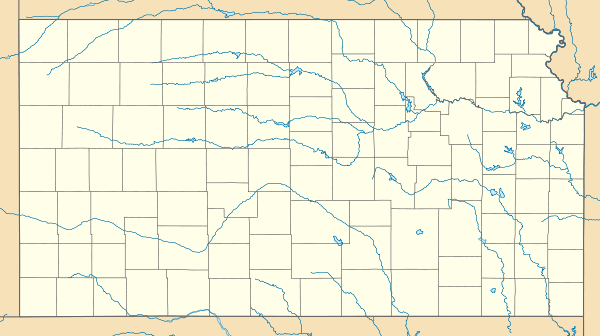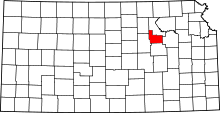Pawnee, Kansas
| Pawnee, Kansas | |
|---|---|
| Ghost town | |
 Pawnee, Kansas Location within the state of Kansas | |
| Coordinates: 39°5′9″N 96°45′45″W / 39.08583°N 96.76250°WCoordinates: 39°5′9″N 96°45′45″W / 39.08583°N 96.76250°W | |
| Country | United States |
| State | Kansas |
| County | Geary |
| Time zone | Central (CST) (UTC-6) |
| • Summer (DST) | CDT (UTC-5) |
Pawnee is a ghost town in Geary County, Kansas, United States, which served as the first official capital of the Kansas Territory in 1855. Pawnee was the territorial capital for exactly five days – from July 2 to July 6, 1855 – before pro-slavery legislators voted to move the capital to Shawnee Mission, which is located in present-day Fairway. It is believed to be one of the shortest-lived capitals of any U.S. state or territory (tied with Old Colorado City, although Colorado City was never federally recognized).
History
One week of glory
Pawnee was located on the far western frontier of newly-settled Kansas Territory, between the new settlement of Manhattan, Kansas, and the U.S. Army post at Fort Riley. Pawnee was first laid out in 1854.[1] Pawnee was selected as capital by Territorial Governor Andrew Reeder in May 1855, after an intense lobbying campaign by several settlements in Kansas Territory. Governor Reeder had an economic interest in selecting Pawnee, since he was a major landowner in the new settlement and had built himself a grand log house there.
The Territorial Legislature, which was composed mostly of pro-slavery delegates from the neighboring state of Missouri, was incensed that Reeder had placed the capital 150 miles from the Missouri border. They felt that the location gave an advantage to the Free-State advocates in Kansas Territory. So, one of the first actions the legislators took was a vote to move to the capital to Shawnee Mission, on the Missouri border. Governor Reeder vetoed the bill moving the capital, but the Territorial Legislature overrode the veto, and the legislators departed Pawnee on July 6. The territorial government reconvened in Shawnee on July 16, 1855.
The destruction of Pawnee
Soon after Pawnee lost its designation as capital, Jefferson Davis, the Secretary of War (and future President of the Confederate States of America), decided to wipe-out the Free-State settlement entirely and ordered the borders of Fort Riley expanded to overtake Pawnee. Most of the town was destroyed by the army subsequent to this order. Only the old capitol building was spared at the location; it is now a museum on Fort Riley property and is listed on the National Register of Historic Places.
References
- ↑ Blackmar, Frank Wilson (1912). Kansas: A Cyclopedia of State History, Volume 2. Standard Publishing Company. p. 451.
